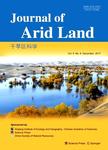Optically stimulated luminescence dating of sandy deposits from Gulang county at the southern margin of the Tengger Desert, China
Optically stimulated luminescence dating of sandy deposits from Gulang county at the southern margin of the Tengger Desert, China作者机构:Key Laboratory of Desert and Desertification Cold and Arid Regions Environmental and Engineering Research InstituteChinese Academy of Sciences Qinghai Institute of Salt Lakes Chinese Academy of Sciences
出 版 物:《Journal of Arid Land》 (干旱区科学(英文版))
年 卷 期:2016年第8卷第1期
页 面:1-12页
核心收录:
学科分类:070903[理学-古生物学与地层学(含:古人类学)] 0709[理学-地质学] 081803[工学-地质工程] 07[理学] 08[工学] 0818[工学-地质资源与地质工程]
基 金:funded by the National Basic Research Program of China(2013CB956000 2012CB426501)
主 题:OSL dating sandy deposit integration interval selection aeolian activity Tengger Desert
摘 要:Aeolian deposits from the deserts in northern China have been used for palaeoenvironmental research to understand aeolian sedimentology and its dynamic connection to past climate conditions. The Tengger Desert in China is sensitive to the waxing and waning of the monsoonal system. In response to past climate change, the southern margin of the Tengger Desert has evolved significantly since the last glacial period. However, previous attempts to date aeolian deposits in this region were mainly based on radiocarbon dating, which has problems when applied to aeolian deposits. Moreover, sedimentary records are limited. Accordingly, past aeolian activity in this desert remains poorly understood. In the present study, we dated sand samples from Gulang county at the southern margin of the Tengger Desert using optically stimulated luminescence (OSL) to understand the history of aeolian activity in this region. Our samples represented well-sorted aeolian sands and sandy loess. Aeolian sands are evidence of dune field buildup and sparse vegetation cover whereas sandy loess is evidence of improved stabilization of sand dunes resulting from ameliorated vegetation cover. Certain samples showed a decline in the equivalent dose (D e ) values when successive integration intervals were applied, which resulted from unstable OSL signals from non-fast components in the initial part of the decay curve. In order to obtain reliable D e estimates, we investigated component-resolved and different background subtraction approaches, and compared the resultant D e estimates. We adopted the early background subtraction method to derive D e values. Luminescence chronologies and sedimentary records indicated that sand dunes accumulation occurred before 10 ka, and sandy loess developed between 9.5 and 7.6 ka when sand dunes were stabilized as a result of increased effective moisture levels. The transition between sand dune mobilization and stabiliza



